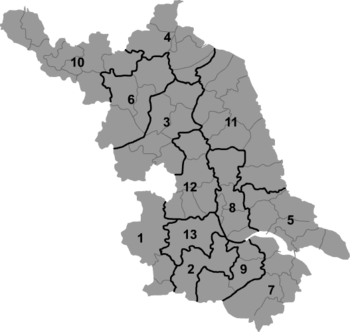Wujiang District, Suzhou
| Wujiang 吴江区 | |
|---|---|
| District | |
|
| |
 Wujiang Location in Jiangsu | |
| Coordinates: 30°59′38″N 120°37′51″E / 30.9938°N 120.6309°ECoordinates: 30°59′38″N 120°37′51″E / 30.9938°N 120.6309°E | |
| Country | People's Republic of China |
| Province | Jiangsu |
| Prefecture-level city | Suzhou |
| County established | 909 |
| Upgraded to county-level city | 1992 |
| Upgraded to district | October 29, 2012 |
| Divisions |
1 Subdistrict: Binghu 8 towns:Songling, Tongli, Pingwang, Shengze, Qidu, Zhengze, Taoyuan, Fenghu |
| Government | |
| • Mayor | Shen Guofang (沈国芳) |
| Area | |
| • Total | 1,176.68 km2 (459.64 sq mi) |
| Population (2010) | |
| • Total | 1,275,000 |
| • Density | 1,084/km2 (423.44/sq mi) |
| Time zone | China Standard (UTC+8) |
| Postal Code | 215200 |
| Area code(s) | 0512 |
| Vehicle registration plates | 苏E |
| Website |
zgwj |
Wujiang District (simplified Chinese: 吴江区; traditional Chinese: 吳江區; pinyin: Wújiāng Qū; Suzhounese: Wukaon Chiu), formerly Wujiang City, is one of five urban districts in Suzhou, Jiangsu province, China. The total area of Wujiang is 1176.68 square kilometers, with a population of 1.5 million. Wujiang is currently one of the most economically successful cities in China. Songling (松陵), a town located at the centre of Wujiang, serves as the seat of the district government.
Geography
Wujiang is located south of the city centre of Suzhou and borders Shanghai to the east. Traditionally, it has been regarded as “The Land of Fish and Rice” and “The Capital of Silk”. In recent years, due to an increase in electronic and computer manufacturing, it has also come to be known as “The Capital of Cable and Optical Cable“ and “The City of Electronics”.[1]
Wujiang is a district with a long history and a plethora of scholars and talents. Due to its traditional culture, its large silkworm population and its colorful historic sites and relics, it has grown in stature as a tourist location in the Yangtze River Delta area of China. Tuisi Garden, a classical private garden dating back to the late Qing Dynasty located in Tongli, is a popular tourist attraction in the district.
Economy
Wujiang currently ranks as one of the most economically successful cities in China. Its GDP in 2007 was 61.8 billion yuan, an increase of 24.4% from 2006. The GDP per capita reached 78,149 yuan (ca. US$10,700) in 2007, an increase of 21.6% from the previous year. The city is home to more than 1,300 foreign enterprises with a total registered investment of US$10 billion.[2]
Major Industrial Sites
- Wujiang Economic Development Zone (WEDZ)
Established in 1993 and ratified by the Jiangsu provincial government, it covers an area of 80 km². There are over 783 foreign enterprises present in it, with a total registered investment amounting to US$4.9 billion. WEDZ has been one of the top IT industry manufacturing sites in China, especially for its section.
- Jiangsu Fenhu Economic Development Zone
Bordering the municipality of Shanghai, the Jiangsu Fenhu Economic Development Zone is one of the youngest provincial economic zones in China with an area of 255 km².
Companies with a significant presence in the region include: Hitachi, NEC, Opple Lighting, Huayin and Everlight.[3]
Major Industrial Sections
Wujiang’s IT industry is developing rapidly and now has a complete supply chain for local development.
There are over 700 IT enterprises in Wujiang, with more than 150 of these having total investments of at least US$10 million. The district mainly produces hardware, including computers, related peripheral devices, mobile phones and LCD monitors. The Wujiang Economic Development Zone is the world's largest manufacturing base of power supply, ADSL device and backlight modules.
The silk and textile industry in Wujiang has a long history. In 2007, the trade volume of the China Eastern Silk Market reached US$6.9 billion. The annual output of various types of fabrics totalled to 7 billion meters. The silk production volume and export volume in Wujiang account for one-eighth and one-sixth of the national total respectively.
Honorary titles
- National Civilization City
- National Excellent Tourism City
- National Advanced Culture City
- National Advanced Education City
- National Exemplary Science and Technology City
- National Exemplary City for Environment Protection
Sister-cities
Wujiang has 7 sister-cities in 6 countries. They are Bourgoin-Jallieu[4] (France), Dubbo[5] (Australia), Chiba[6] (Japan), Hwaseong (South Korea), Uchinada (Japan), Mogale (South Africa) and Marlboro, NJ[7] (United States).
See also
References
External links
- Wujiang City English guide (Jiangsu.NET)
- http://www.foho.gov.cn/cn/newsqye.aspx
- http://www.jshb.gov.cn/jshbw/wrfz/qjsc/zdqysh/201011/t20101101_162581.html
